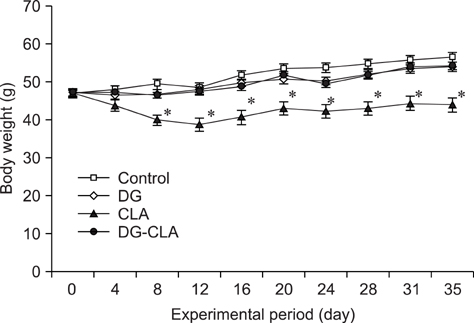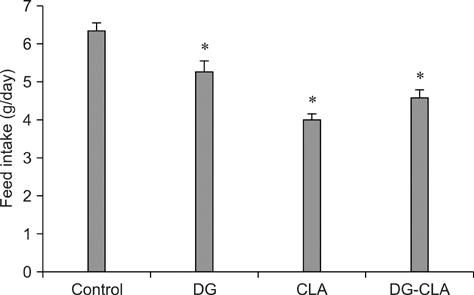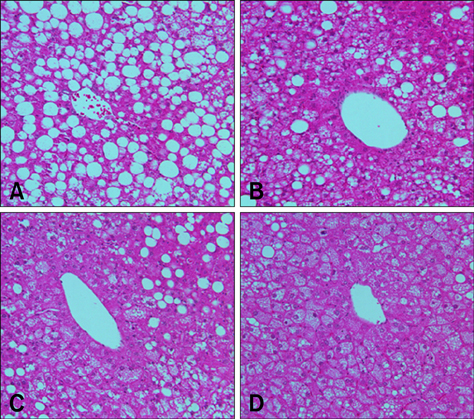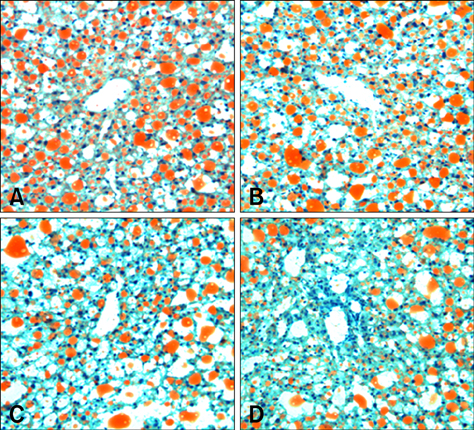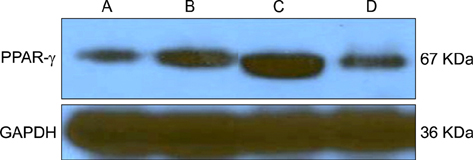J Vet Sci.
2009 Sep;10(3):189-195. 10.4142/jvs.2009.10.3.189.
Anti-obesity activity of diglyceride containing conjugated linoleic acid in C57BL/6J ob/ob mice
- Affiliations
-
- 1College of Veterinary Medicine and Research Institute of Veterinary Medicine, Chungbuk National University, Cheongju 361-763, Korea. beomjun@cbu.ac.kr
- 2Department of Biotechnology and Biomedicine, Chungbuk Province College, Okcheon 373-807, Korea.
- 3Department of Food and Nutrition, Seowon University, Cheongju 361-742, Korea.
- 4Ilshinwells, Cheongwon 363-890, Korea.
- KMID: 1726917
- DOI: http://doi.org/10.4142/jvs.2009.10.3.189
Abstract
- This study was to investigate the anti-obesity effects of diglyceride (DG)-conjugated linoleic acid (CLA) containing 22% CLA as fatty acids in C57BL/6J ob/ob male mice. There were four experimental groups including vehicle control, DG, CLA, and DG-CLA. The test solutions of 750 mg/kg dose were orally administered to the mice everyday for 5 weeks. CLA treatments significantly decreased mean body weight in the obese mice throughout the experimental period compared to the control (p < 0.01). All test solutions significantly decreased the levels of triglyceride, glucose and free fatty acids in the serum compared with control (p < 0.05). The levels of total cholesterol were also significantly reduced in DG and DG-CLA groups compared with the control group (p < 0.05). CLA significantly decreased weights of renal and epididymal fats compared with the control (p < 0.05). DG and DG-CLA also significantly decreased the epididymal fat weights compared with the control (p < 0.05). A remarkable decrease in the number of lipid droplets and fat globules was observed in the livers of mice treated with DG, CLA, and DG-CLA compared to control. Treatments of DG and CLA actually increased the expression of peroxisome proliferator-activated receptor gamma. These results suggest that DG-CLA containing 22% CLA have a respectable anti-obesity effect by controlling serum lipids and fat metabolism.
MeSH Terms
-
Adipose Tissue/*drug effects
Animals
Anti-Obesity Agents/*pharmacology
Blood Chemical Analysis
Body Weight/*drug effects
Diglycerides/*pharmacology
Disease Models, Animal
Eating/drug effects
Gene Expression Regulation/drug effects
Linoleic Acids, Conjugated/*pharmacology
Lipids/blood
Liver/drug effects/pathology
Male
Mice
Mice, Inbred C57BL
Mice, Obese
Obesity/*metabolism/pathology
PPAR gamma/metabolism
Time Factors
Figure
Reference
-
1. Azain MJ, Hausman DB, Kasser TR, Martin RJ. Effect of somatotropin and feed restriction on body composition and adipose metabolism in obese Zucker rats. Am J Physiol. 1995. 269:E137–E144.
Article2. Banni S, Carta G, Angioni E, Murru E, Scanu P, Melis MP, Bauman DE, Fischer SM, Ip C. Distribution of conjugated Linoleic acid and metabolites in different lipid fractions in the rat liver. J Lipid Res. 2001. 42:1056–1061.
Article3. Bedoucha M, Atzpodien E, Boelsterli UA. Diabetic KKAy mice exhibit increased hepatic PPARgamma1 gene expression and develop hepatic steatosis upon chronic treatment with antidiabetic thiazolidinediones. J Hepatol. 2001. 35:17–23.
Article4. Bocher V, Pineda-Torra I, Fruchart JC, Staels B. PPARs: transcription factors controlling lipid and lipoprotein metabolism. Ann N Y Acad Sci. 2002. 967:7–18.
Article5. Blond JP, Henchiri C, Bézard J. Delta 6 and delta 5 desaturase activities in liver from obese Zucker rats at different ages. Lipids. 1989. 24:389–395.
Article6. Brown JM, McIntosh MK. Conjugated linoleic acid in humans: regulation of adiposity and insulin sensitivity. J Nutr. 2003. 133:3041–3046.
Article7. Burant CF, Sreenan S, Hirano K, Tai TA, Lohmiller J, Lukens J, Davidson NO, Ross S, Graves RA. Troglitazone action is independent of adipose tissue. J Clin Invest. 1997. 100:2900–2908.
Article8. Chao L, Marcus-Samuels B, Mason MM, Moitra J, Vinson C, Arioglu E, Gavrilova O, Reitman ML. Adipose tissue is required for the antidiabetic, but not for the hypolipidemic, effect of thiazolidinediones. J Clin Invest. 2000. 106:1221–1228.
Article9. Chawla A, Schwarz EJ, Dimaculangan DD, Lazar MA. Peroxisome proliferator-activated receptor (PPAR) gamma: adipose-predominant expression and induction early in adipocyte differentiation. Endocrinology. 1994. 135:798–800.
Article10. Chin SF, Liu W, Storkson JM, Ha YL, Pariza MW. Dietary sources of conjugated dienoic isomers of linoleic acid, a newly recognized class of anticarcinogens. J Food Comp Anal. 1992. 5:185–197.
Article11. DeLany JP, Blohm F, Truett AA, Scimeca JA, West DB. Conjugated Linoleic acid rapidly reduces body fat content in mice without affecting energy intake. Am J Physiol. 1999. 276:R1172–R1179.12. Fajas L, Auboeuf D, Raspé E, Schoonjans K, Lefebvre AM, Saladin R, Najib J, Laville M, Fruchart JC, Deeb S, Vidal-Puig A, Flier J, Briggs MR, Staels B, Vidal H, Auwerx J. The organization, promoter analysis, and expression of the human PPARgamma gene. J Biol Chem. 1997. 272:18779–18789.
Article13. Flegal KM. Epidemiologic aspects of overweight and obesity in the United States. Physiol Behav. 2005. 86:599–602.
Article14. Granlund L, Pedersen JI, Nebb HI. Impaired lipid accumulation by trans10, cis12 CLA during adipocyte differentiation is dependent on timing and length of treatment. Biochim Biophys Acta. 2005. 1687:11–22.
Article15. Hihi AK, Michalik L, Wahli W. PPARs: transcriptional effectors of fatty acids and their derivatives. Cell Mol Life Sci. 2002. 59:790–798.
Article16. Houseknecht KL, Vanden Heuvel JP, Moya-Camarena SY, Portocarrero CP, Peck LW, Nickel KP, Belury MA. Dietary conjugated linoleic acid normalizes impaired glucose tolerance in the Zucker diabetic fatty fa/fa rat. Biochem Biophys Res Commun. 1998. 244:678–682.
Article17. Kissebah AH, Krakower GR. Regional adiposity and morbidity. Physiol Rev. 1994. 74:761–811.
Article18. Lambert PD, Anderson KD, Sleeman MW, Wong V, Tan J, Hijarunguru A, Corcoran TL, Murray JD, Thabet KE, Yancopoulos GD, Wiegand SJ. Ciliary neurotrophic factor activates leptin-like pathways and reduces body fat, without cachexia or rebound weight gain, even in leptin-resistant obesity. Proc Natl Acad Sci USA. 2001. 98:4652–4657.
Article19. Lee KN, Kritchevsky D, Pariza MW. Conjugated linoleic acid and atherosclerosis in rabbits. Atherosclerosis. 1994. 108:19–25.
Article20. Lee KN, Pariza MW, Ntambi JM. Conjugated linoleic acid decreases hepatic stearoyl-CoA desaturase mRNA expression. Biochem Biophys Res Commun. 1998. 248:817–821.
Article21. Lefebvre AM, Chen I, Desreumaux P, Najib J, Fruchart JC, Geboes K, Briggs M, Heyman R, Auwerx J. Activation of the peroxisome proliferator-activated receptor gamma promotes the development of colon tumors in C57BL/6J-APCMin/+ mice. Nat Med. 1998. 4:1053–1057.
Article22. Lin H, Boylston TD, Chang MJ, Luedecke LO, Shultz TD. Survey of the conjugated linoleic acid contents of dairy products. J Dairy Sci. 1995. 78:2358–2365.
Article23. Memon RA, Tecott LH, Nonogaki K, Beigneux A, Moser AH, Grunfeld C, Feingold KR. Up-regulation of peroxisome proliferator-activated receptors (PPAR-alpha) and PPAR-gamma messenger ribonucleic acid expression in the liver in murine obesity: troglitazone induces expression of PPAR-gamma-responsive adipose tissue-specific genes in the liver of obese diabetic mice. Endocrinology. 2000. 141:4021–4031.
Article24. Miner JL, Cederberg CA, Nielsen MK, Chen X, Baile CA. Conjugated linoleic acid (CLA), body fat, and apoptosis. Obes Res. 2001. 9:129–134.
Article25. Moore KJ, Fitzgerald ML, Freeman MW. Peroxisome proliferator-activated receptors in macrophage biology: friend or foe? Curr Opin Lipidol. 2001. 12:519–527.
Article26. Must A, Spadano J, Coakley EH, Field AE, Colditz G, Dietz WH. The disease burden associated with overweight and obesity. JAMA. 1999. 282:1523–1529.
Article27. Murase T, Aoki M, Wakisaka T, Hase T, Tokimitsu I. Anti-obesity effect of dietary diacylglycerol in C57BL/6J mice: dietary diacylglycerol stimulates intestinal lipid metabolism. J Lipid Res. 2002. 43:1312–1319.
Article28. Murase T, Mizuno T, Omachi T, Onizawa K, Komine Y, Kondo H, Hase T, Tokimitsu I. Dietary diacylglycerol suppresses high fat and high sucrose diet-induced body fat accumulation in C57BL/6J mice. J Lipid Res. 2001. 42:372–378.
Article29. Nagao T, Watanabe H, Goto N, Onizawa K, Taguchi H, Matsuo N, Yasukawa T, Tsushima R, Shimasaki H, Itakura H. Dietary diacylglycerol suppresses accumulation of body fat compared to triacylglycerol in men in a double-blind controlled trial. J Nutr. 2000. 130:792–797.
Article30. Ntambi JM, Kim YC. Adipocyte differentiation and gene expression. J Nutr. 2000. 130:3122S–3126S.
Article31. Ogden CL, Carroll MD, Curtin LR, McDowell MA, Tabak CJ, Flegal KM. Prevalence of overweight and obesity in the United States, 1999-2004. JAMA. 2006. 295:1549–1555.
Article32. Ohnuki K, Haramizu S, Ishihara K, Fushiki T. Increased energy metabolism and suppressed body fat accumulation in mice by a low concentration of conjugated linoleic acid. Biosci Biotechnol Biochem. 2001. 65:2200–2204.
Article33. Pariza MW, Park Y, Cook M. The biologically active isomers of conjugated Linoleic acid. Prog Lipid Res. 2001. 40:283–298.
Article34. Parodi PW. Cows' milk fat components as potential anticarcinogenic agents. J Nutr. 1997. 127:1055–1060.
Article35. Park Y, Albright KJ, Storkson JM, Liu W, Cook ME, Pariza MW. Changes in body composition in mice during feeding and withdrawal of conjugated linoleic acid. Lipids. 1999. 34:243–248.
Article36. Park Y, Storkson JM, Albright KJ, Liu W, Pariza MW. Evidence that the trans-10, cis-12 isomer of conjugated linoleic acid induces body composition changes in mice. Lipids. 1999. 34:235–241.
Article37. Parker J, Daniel LW, Waite M. Evidence of protein kinase C involvement in phorbol diester-stimulated arachidonic acid release and prostaglandin synthesis. J Biol Chem. 1987. 262:5385–5393.
Article38. Taguchi H, Nagao T, Watanabe H, Onizawa K, Matsuo N, Tokimitsu I, Itakura H. Energy value and digestibility of dietary oil containing mainly 1,3-diacylglycerol are similar to those of triacylglycerol. Lipids. 2001. 36:379–382.
Article39. Terpstra AHM, Javadi M, Beynen AC, Kocsis S, Lankhorst AE, Lemmens AG, Mohede ICM. Dietary conjugated linoleic acids as free fatty acids and triacylglycerols similarly affect body composition and energy balance in mice. J Nutr. 2003. 133:3181–3186.
Article40. Wargent E, Sennitt MV, Stocker C, Mayes AE, Brown L, O'Dowd J, Wang S, Einerhand AW, Mohede I, Arch JR, Cawthorne MA. Prolonged treatment of genetically obese mice with conjugated linoleic acid improves glucose tolerance and lowers plasma insulin concentration: possible involvement of PPAR activation. Lipids Health Dis. 2005. 4:3.41. West DB, Delany JP, Camet PM, Blohm F, Truett AA, Scimeca J. Effects of conjugated linoleic acid on body fat and energy metabolism in the mouse. Am J Physiol. 1998. 275:R667–R672.
- Full Text Links
- Actions
-
Cited
- CITED
-
- Close
- Share
- Similar articles
-
- Hog millet (Panicum miliaceum L.)-supplemented diet ameliorates hyperlipidemia and hepatic lipid accumulation in C57BL/6J-ob/ob mice
- Isomer specificity of conjugated linoleic acid (CLA): 9E,11E-CLA
- Early Sensorineural Hearing Loss in Ob/Ob Mouse, an Animal Model of Type 2 Diabetes
- Effects of Cyclo-His-Pro-enriched yeast hydrolysate on blood glucose levels and lipid metabolism in obese diabetic ob/ob mice
- Increased Plasma Dipeptidyl Peptidase IV Activities in ob/ob Mice

